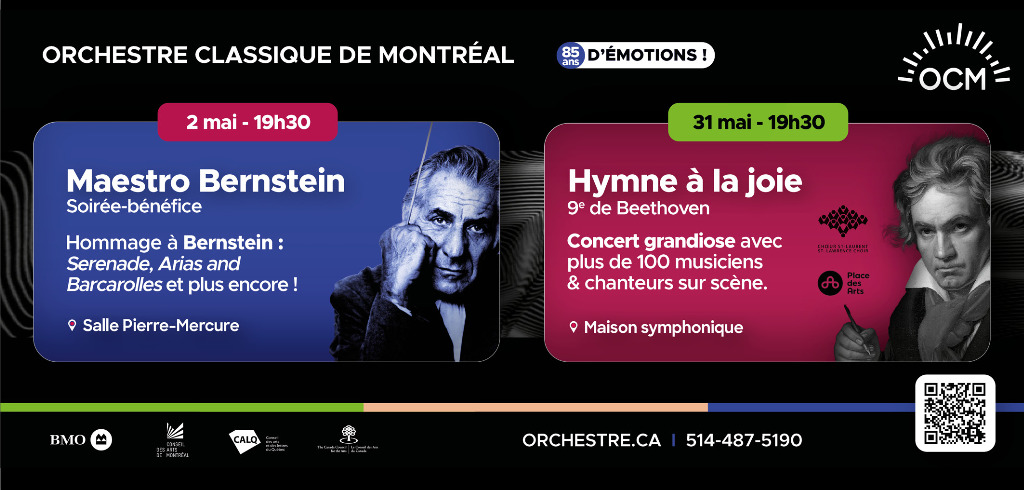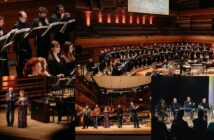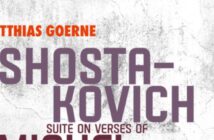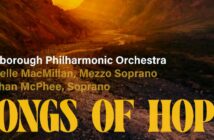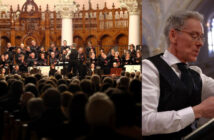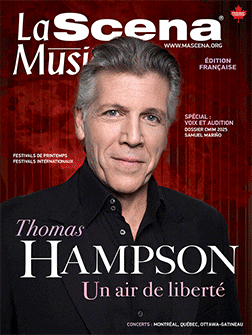This page is also available in / Cette page est également disponible en:
![]() English (Anglais)
English (Anglais)
Nous célébrons aujourd’hui le 250e anniversaire de naissance de Ludwig van Beethoven.
Baptisé le 17 décembre 1770 à Bonn, le compositeur affirmait lui-même être né le 16. Voici les oeuvres préférées de notre équipe!
Sonate pour piano no 32 en ut mineur, op. 111
Andréanne Venne
On l’a appelée l’adieu au piano de Beethoven et même l’adieu à la sonate.
Mon inclination pour le dépouillement a d’abord déterminé ma préférence pour le piano solo. Dans la Sonate pour piano no 32 en ut mineur, op. 111, la voix du piano communique une solitude souveraine. Mais, pourquoi ai-je choisi cette sonate en particulier ?
Pour la gravité tempétueuse des notes qui fuguent entre la valse lourde et la tourmente, qui se poursuivent fiévreusement comme les images d’un vieux film d’animation triste. L’harmonie qui semble à tout moment vouloir se rompre sans jamais perdre son air affirme avec puissance sa perfection. La rondeur de l’ensemble nous enveloppe d’une fracassante cohésion mélancolique.
Si quelques sonates se sont vu attribuer des sobriquets, comme la fameuse Sonate au clair de lune (Sonate nᵒ 14 en do dièse mineur, opus 27 nᵒ 2), celle-ci pourrait bien mériter, à mon sens, celui de Sonate du tonnerre.
Ultimate Beethoven: The Late Piano Sonatas and Late String Quartets
Phil Ehrensaft
As one of the great virtuoso pianists of his time, Beethoven first composed his new ideas at the keyboard, then moved to a second stage in his orchestral music and moved into the ultimate phase with his string quartets. The Arditti String Quartet, ardent champions of New Music, would only perform one set of pre-1900 compositions: Beethoven’s late quartets, on the basis that it took three-quarters of a century for other composers to catch up on what he started.
For the late piano sonatas, that’s a very hard choice. From the first recordings of the complete Beethoven sonatas by Artur Schnabel during the 1930’s through the present, masters have climbed this ultimate pianistic mountain. Among this embarrassment of riches, I’m listening most to Toronto’s Stewart Goodyear, who performs the late sonatas at the rapid speed indicated by Beethoven’s metronome markings, at a comfort level that enables him to focus on interpretation (Marquis Classics, 2010).
Tidal HD, a pioneer in streaming music in CD quality, and now in super-audio for recordings remastered in MQA (superaudio) quality, there’s a staggering choice of complete Beethoven string quartet cycles. Which is pretty damn good for a service run by a rap star turned music moghul. I’m currently listening to the late quartets in the Takács Quartet complete Beethoven cycle for three reasons: 1) this set streams in super-audio quality; 2) it is the Takács Quartet; and 3) it is the Takács Quartet.
Le Quatuor à cordes no 1 en fa majeur, opus 18 no. 1
Dino Spaziani
Symphony No. 2
Robert Markow
Beethoven’s Second Symphony probably holds the dubious distinction of being the least known of the composer’s nine works in the genre. Why this should be so is something of a mystery. It crashes in with an immensely powerful outburst from the full orchestra, only to dissolve into utterly gracious lyricism from the woodwind choir. An opening so startling can only herald a work of vast scope and grandeur, and indeed, this symphony turned out to be longest written to date (a record Beethoven himself promptly broke again with his next symphony, the Eroica). Then there is all that rough humor. In the Scherzo, for instance, we regularly encounter asymmetrical arrangements of loud and soft presentations of a three-note motif (“ha-ha-ha”) as it is tossed about the orchestra, sometimes in shouts, sometimes in whispers ̶ an unsettling effect. Or what about the material that opens the rambunctious finale – the musical equivalent of a hiccup, a growl, a burp, and a fairy dance, all within the space of a few seconds? But best of all is this symphony’s slow movement – one of the most gorgeous creations in all Beethoven, with a serene beauty worthy of Schubert. The outstanding Columbian-born conductor Andrés Orozco-Estrada leads the Frankfurt Radio Symphony Orchestra, one of Germany’s best, in a performance that bristles with energy and excitement, enhanced by the astringent sounds of period trumpets and horns.
Sonate pour piano No. 27 en mi mineur, op. 90
Justin Bernard
Piano Sonata Op. 54
Arthur Kaptainis
Beethoven’s two-movement Piano Sonata Op. 54 is wedged between two nicknamed masterpieces – the “Waldstein”: and the “Appassionata” – and disregarded accordingly. In fact it packs full Beethovenian helpings of elegance and energy into less than 11 minutes. I got hooked long ago by a 1960 RCA studio recording by Sviatoslav Richter that served as a filler on a recording of the Piano Concerto No. 1 with the Boston Symphony under Charles Munch (which is also worth your attention). Listen to the way the Russian master unleashes the force of the trio in octaves and sixths after the deceptively gracious minuet of the first movement, punching out the sforzandos with virtuoso authority. I have a feeling we are not in the classical era anymore! The perpetuum mobile finale starts at a murmuring Allegretto before gearshifting up to a hair-raising Più Allegro. Richter turns this overlooked score into a tour de force.
This page is also available in / Cette page est également disponible en:
![]() English (Anglais)
English (Anglais)


